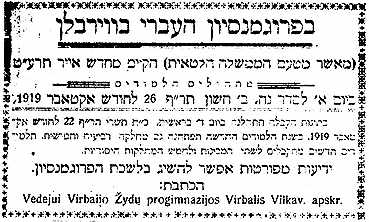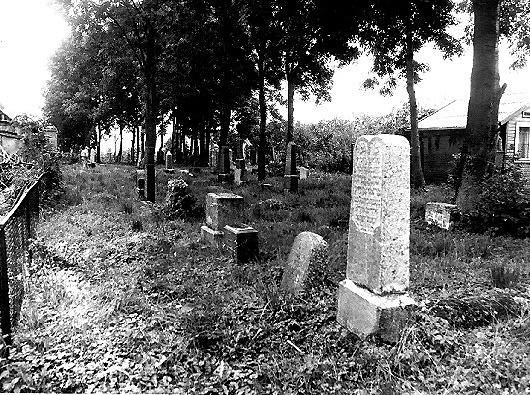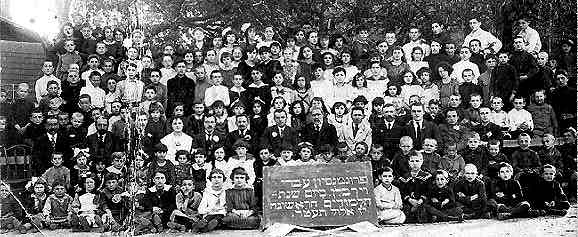During the Period of Independent Lithuania
Public and Economic Life
With the establishment of the Lithuanian State in 1918, Virbaln
citizens began to return to their town. After the eviction of the
German army at the beginning of 1919, life in Virbaln returned to
normal. Virbaln was included in the Vilkavishk (Vilkaviskis)
district.
According to the Autonomy Law Regarding Minorities in Lithuania,
elections for the Jewish Community Committee in Virbaln took place.
Eleven members were elected: 2 from the list of "Tseirei Zion", 5
from "Mizrachi", 2 Artisans and 2 Independents. The Committee was
active until the end of 1925 when the Autonomy was annulled. During
the years of its existence the Committee collected taxes as required
by law, sometimes with the help of the Police, and was in charge of
all areas of community life.
According to the first census conducted by the Lithuanian
Government in 1923 there were 4,018 people in Virbaln, among them
1,233 Jews (31%).
During this period Virbaln Jews made their living in commerce,
craft, agriculture and industry. The border between Lithuania and
Germany remained the same as during the Tzar's rule. Likewise, it was
an important factor of the life of Virbaln Jews. The export of
poultry, geese and other agricultural products provided a living for
many families in town. In addition the town had 5 Jewish grocery
shops, 7 butchers, 6 bakeries, 3 shops for tools and iron products, 5
shoemakers, 4 tailors, 2 glaziers, 2 tinsmiths, 2 hairdressers, 2
tombstone builders, 2 watchmakers, 1 photographer and one tavern
owned by Jews.
Many of Virbaln's Jews made their living in agriculture. Several
Jews were owners of big fields in the vicinity and during
agricultural season they employed hundreds of workers. Most of them
cultivated grain crops but there were others who grew cucumbers, beet
root and fruits. (Fridlender, Vladislavovsky, Skudsky, Hilenberg,
Gringard, Berezdovsky, and others).
Agronomist Ya'akov Filipovsky was respected and praised as the
greatest specialist in cultivating species of fruit trees and berries
in Lithuania. His nursery in Virbaln supplied seeds to most of the
gardeners in Lithuania. Gardeners from all over Lithuania would come
to his show garden to advance their knowledge. He also grew seeds of
cucumbers and beets for fodder.
Virbaln Jews by the name of Zerko and Kamber built a power station
in Virbaln which supplied the town with electricity. Jews also owned
a flour mill (Miler), a sawmill (Lakovsky), a few oil factories
(Kagansky and Ridlitzky), a metal casting plant (Zerko) and chicory
production (Kapushevsky). There was a Jewish doctor (L.Kagansky), a
Jewish dentist (Mrs. Pauzisky) and a Jewish pharmacy (Ziman) in
Virbaln.
The brushes industry employed hundreds of workers as before the
war.
In 1937 there were fifty two Jewish artisans in Virbaln: 10
butchers, 7 bakers, 7 shoemakers, 5 hairdressers, 4 tailors, 4
watchmakers, 3 stitchers, 3 painters, 3 tinsmiths, 2 hat makers, 2
cloth dyers, 2 photographers, 1 potter. In 1939 Virbaln had 41
telephone subscribers, among them 21 belonged to Jews (51%).
In the centre of economic life in Virbaln was the Jewish Folksbank
with 320 members in 1927. In 1929 the number grew to 342.
There was also a branch of "The United Company for Financial
Credit for Jewish Agrarians" in town.
Till 1934 there were 4 Jews in the Town Council among a total of 9
Council members (Leizer Kagansky, Joseph Pagramat, Moshe
Vishtinetsky, Volf Neishtot). However, only 3 Jews were elected
(Kagansky, Vishtinetsky, Chaimovitz) in the elections of 1934. For
many years Virbalní had a Jewish Deputy Mayor.
The Volunteer Fire Brigade fulfilled an important role in town.
Most of its members were Jews for many years working under the
leadership of Gedalia Abeloviz.
With the beginning of the Nazi rule in 1933 in Germany, trade with
this country gradually diminished. Traffic through Kibart, the nearby
border town decreased, and only a few Jews would pass through on
their way to Eydtkuhnen - the German town on the other side of the
border. This had a substantial influence on the economic situation,
and many Jews left Virbaln, in particular the youth. Most of them
moved to Kovno and a part immigrated abroad, or to Eretz-Israel.
Education
After the end of the War in 1918 children's education became an
issue in Virbaln. A group of activists understood that the "Cheder
Metukan" (Improved Cheder) no longer fulfilled the task of education
under the new conditions. An idea was born to establish a Hebrew high
school in town, preceded shortly by the founding of the first Hebrew
high school of the Diaspora in Mariampol. It was clear to the
initiators that a small community of only 1,200 people could not
stand that heavy burden. They were faced with competition of schools
in the nearby German towns, where Jewish children from Kibart were
enrolled. Thus a decision was reached that the school would accept
children from neighbouring towns, mainly Kibart, Vishtinetz and
Neishtot- Shaki. Registration started at the 29th of Iyar 5679
(1919).
 Announcement (in Hebrew) in the Jewish press in
Lithuania regarding the commencement of studies in the Hebrew
High-School in Virbalis on the September 26, 1919
Announcement (in Hebrew) in the Jewish press in
Lithuania regarding the commencement of studies in the Hebrew
High-School in Virbalis on the September 26, 1919
Until 1921 the school offered a program equivalent to half of the
high-school curriculum (pro gymnasium) but later it changed
introducing a complete high school education. In 1929 the board of
directors of the school acquired a two story, red brick building on
the main street, renovated and redesigned to suit the needs. Central
heating was installed, a novelty in these days. The school had
physics and nature laboratories.
Students came from all walks of life. Some arrived from schools in
Russia; others were from German schools operating under the
jurisdiction of German occupation and still others came from
"Chadarim" and "Yeshivoth". They were of different age groups and a
varied elementary school background. Most of them did not have a
proper knowledge of the Hebrew Language. There was no curriculum,
textbooks or teaching materials.
Owing largely to the efforts of Virbaln and Kibartai
Jews who acted to assure a budget for the school and to the devotion
of the teachers' team and their director Dr. Ya'akov Rabinson a
splendid institution was established. Dr. Ya'akov Rabinson who was a
native of Vishtinetz (Vistytis) and a graduate from Germany returned
to Lithuania to accomplish this difficult pioneering task. A known
lawyer and public servant, he became later the advisor to the
Lithuanian Foreign Ministry before World War II and later the legal
adviser of the Israeli delegation to the UN.
1925 was the year of the first graduating class. Among its first
teachers - Avraham Eliyahu Sandler, Mitkovsky, Masha Frenkel, Dudnik,
Shilansky, Aharon Frank, Moshe Frank, Fridman, Reizel Rozenblum (the
daughter of A.E.Sandler), Geisinovitz (later known as Aba Achimeir,
one of the leaders of the Revisionist Party in Eretz- Israel),
Sambursky, later professor of mathematics at the Hebrew University in
Jerusalem, Ash-Bartana, subsequently a teacher of mathematics in the
"Rechavia" high school in Jerusalem. Reuven Kaplan was Secretary of
the school throughout its existence.
In the middle of the twenties Director Dr. Rabinson left the
school, and Dr. Shnitzler was nominated as the incumbent. Later,
Michael Bramson was appointed who was a tall, slender man, a former
captain of the Lithuanian army, a strict disciplinarian, and thought
to be among the best teachers of the Lithuanian language. During
these years many teachers changed, among them the Bible teacher Mr.
Salant who was popular with the students. He emigrated to
Eretz-Israel and taught for many years at the Kibbutz Ein-Harod.
Nature was taught by Mr. Tzimbalist who subsequently came to
Eretz-Israel. The Lithuanian language teacher was Mr. Katz, while
B.Shulgaser, an immensely popular amateur actor, taught English. His
wife Mrs. Shohat-Shulgaser taught German. A strict disciplinarian,
she appeared for her classes elegantly dressed and made up, which was
unusual in those times. Mr. Kizel, a quiet and modest man, very
popular with his students, taught Hebrew and literature in higher
grades. Mr. Lifshitz was the teacher of drawing, but students holding
the subject in low esteem, made him suffer. The teacher of
mathematics was Tabachovitz. and others included Averbuch and
Yerushalmi.
 The Eighth Graduating Class of Virbaln Hebrew High-
School (1933?)
The Eighth Graduating Class of Virbaln Hebrew High-
School (1933?)
The Teachers are in the rectangles. At the first
row above from right: Salant, M.Bramson, and Dr.Y. Rabinson,
Averbuch.
At the second row: ---, F.Shochat, Shulgaser, - --,Dr.A.Pozisky
(?), --- , Linde
At the third row: D.Katz, Sh.Kizel, A.E.Sandler, R.Kaplan,
Lifshitz, and L.Lakovsky.
In the rectangle below the building of the High-School
In 1934 the government closed the high school, and a pro-gymnasium
with four classes opened in place of the old school, with Tabachovitz
as director. A year later he was asked to take over the position of
director of the Hebrew High School in Mariampol.
M.Bramson, the former director of the Virbalis High School, moved
to Kovno where he subsequently founded the Jewish-Lithuanian High
School.
The High School in Virbalis was closed because of low enrollment
in the higher grades and a budget deficit. The pro-gymnasium was a
private school and was administered by a special "Haskala" Committee
whose chairman was Michael Shadchanovitz from Kibart. He often
covered deficits with his own money. This school functioned until
Lithuania became the Soviet Republic in the summer of 1940; It was
then that the Hebrew Education Network, the pride of Lithuanian
Jewry, was dismissed.
Elementary education for Jewish children was accessible through
the Hebrew Kindergarten and the Hebrew school of the "Tarbuth"
(Culture) Branch. There was also a governmental school where Yiddish
was taught with no tuition fees required. A few dozen of poor
children studied at the school.
Religion and Welfare
In Virbaln there were two big Synagogues and four or five
"Kloisim" (small praying rooms). Many children on "Ben Zakai"
fellowship studied "Gemara" in the evenings and "Agada" (Fables) from
Bialik and Ravnitzky "Sefer ha'Agada" books before lunch on
Saturdays. "Sha's" (Mishna) society was active in Virbaln as well.
The Rabbis of Virbaln were Yehuda Blumgard (from 1872),
David-Tevele Katsenelboigen (1850-1931), Efraim Lap(1859-1926), also
active in the "Zionist Association" and Yitschak Hirshovitz
(1871-1941), the last Rabbi of Virbaln who was a member of the
"Yavneh" centre (a chain of Religious-Zionist schools). He was
murdered in the Holocaust.
 The Remains of the Jewish Cemetery in Virbaln
(1995)
The Remains of the Jewish Cemetery in Virbaln
(1995)
During World War I, when refugees flocked into town a relief
committee was formed in Virbaln to help the absorption and settlement
of a large number of refugees.
Among its welfare institutions Virbaln had "Bikur Cholim", a Women
Fellowship, "Gemiluth Chesed" established with the funds of Aba
Vishtinetsky. In 1939 when refugees from Poland escaped to Lithuania,
the National Committee, that was established for this purpose decided
that Virbaln should absorb 100 refugees, and the community fulfilled
that task.
Zionist Activity
Virbaln was known for its Zionist ambiance. Many of its people
spoke Hebrew acquired at the "Chadarim Metukanim" before the Hebrew
High School was established. For many years Hebrew signs were
displayed on Jewish stores, despite strict rules. The Hebrew
elementary school and the Hebrew high-school educated students
promoting Aliyah to Eretz-Israel. Many graduates of that high school
are presently residing in Israel.
The "Hechalutz" movement can be traced back in Virbaln as early as
1919, when a group of Chalutzim (Pioneers) united under the name
"Cheiruth" (Freedom). Having acquired training with Lithuanian
peasants during a period of one-year ("Hachshara" -preparation) the
group immigrated to Eretz-Israel.
Another group "Achva" followed them. Many groups of "Chalutzim"
got their training at the farm "Kibush" (Conquest) near Kibart and in
other Lithuanian and Jewish farms in the vicinity (April,
Shatenshtein, Rozenberg etc.) The Zionist circles in town and youth
in particular ardently supported the training. In 1934 an urban
Kibbutz of "Hechalutz" was organised in the town itself.
A branch of "haShomer-haTsair" the first in Lithuania was
established in Virbaln in 1921. There were about fifty members of
different ages. A similar number of members could be found in the
"Beitar" branch established some time later. There was also a branch
of "Netzach" (abbreviation of Zionist Pioneer Youth) in Virbaln.
Zionist ambience in town was evident in the elections to the first
Lithuanian Seimas (Parliament) in October 1922. 324 votes were cast
for the Zionist list, 128 for "Achduth" (Agudath- Israel) and 36 for
the Democrats. The number of votes for the Zionist Congresses
increased from 36 in 1927 (the 16th Congress) to 278 in 1935 (the
19th Congress). In the table below results of the elections for the
Zionist Congresses 15th-19th (1927- 1935) in Virbaln are presented.
|
Congr. Number
|
Year
|
Total Shkalim
|
Total Voters
|
Labour
Party
Z"S**----- Z"Z**
|
Revisionists
|
General Zionists
A -----------B
|
Grosman.
|
Mizrachi
|
|
14
|
1925
|
40
|
--
|
--
|
--
|
--
|
--
|
--
|
--
|
--
|
|
15
|
1927
|
60
|
36
|
4
|
5
|
--
|
14
|
--
|
--
|
13
|
|
16
|
1929
|
147
|
42
|
7
|
2
|
1
|
23
|
--
|
--
|
9
|
|
17
|
1931
|
81
|
63
|
22
|
4
|
6
|
26
|
--
|
--
|
5
|
|
18
|
1933
|
--
|
192
|
129
|
29
|
22
|
--
|
5
|
7
|
|
19
|
1935
|
300
|
278
|
206
|
--
|
5
|
27
|
7
|
33
|
** Z"S means Zionist-Socialist, Z"Z means
Zeirei
Zion
(Tseirei Zion).
|
Among the prominent personalities of Virbaln we find Kalev
Blumgard (1808-1897), Baruch ben Shmuel Vizhansky (died 1899); Feivel
Gringard (died 1951 in Tel-Aviv). They were the first Zionists in
town. Another couple Mordechai and Sarah Hilenberg educated their
children in Hebrew and offered their house as a meeting place for all
Zionists. Mordechai Hilenberg together with Ridlitzky and Pargamut
were among the founders of the Hebrew High School in Virbaln.
Among the natives of Virbaln were Nechemia Volpiansky (1877-1937),
a writer, a musician and a chess player; Zvi- Hirsh Filipovsky
(1816-1872), a mathematician and an editor, Gregory Sanders - the son
of A.E.Sandler, who was the first reporter from Canada for the Jewish
newspaper "Der Freind" published in St.Petersburg, Masha Benia
(Benyakonsky), a known popular singer of Yiddish and Hebrew songs in
USA, Dr. Mendel Sudarsky, who spent his youth in Virbaln, and was the
steering power behind many cultural institutions in Lithuania. He was
the chairman of the management of "ORT" in Lithuania and a member its
world centre as well as of the "OZE" and "HIAS". He was the publisher
and the editor of the Yiddish daily newspaper in Kovno "Folksblat".
In 1937 he and his family immigrated to America where he continued to
work for the Yiddish periodicals "Tog", "Forvertz" and others. He was
the publisher and editor of the two volumes of the book "Lite", the
great remembrance project dedicated to Lithuanian Jewry.
Compiled by
Joseph
Rosin
Updated by JA March 2, 1999
Copyright © 1999 Joseph
Rosin



